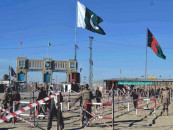131,000 new IDPs since March, report reveals
Calls for improvement in IDP registration mechanism.

Calls for improvement in IDP registration mechanism.
A recent report of the Internal Displacement Monitoring Cell (IDMC) and the United Nations High Commission for Refugees (UNHCR) claims that as many as 131,000 persons have become internally displaced in the country since March this year. The figure does not include many of them who are unregistered.

The report says in Pakistan the internally displaced persons (IDPs) exceeds 415,000 for the year 2012. About 1.1 million IDPs registered as displaced by conflict in the north-west of Pakistan.
As many as five million people have been displaced by conflict, sectarian violence and widespread human-rights abuses in the entire north-western part of the country since 2004. Disaster induced displacement has been even more extensive. Around 15 million people were displaced across the country by three years of monsoon floods between 2010 and 2012, and millions more by earthquakes and drought over the years, the report adds. While the magnitude of conflict-related displacement reached its peak in 2009 when three million people were displaced, by the end of 2010, the number of IDPs had fallen to around one million. Since then, returns have been offset by new displacements.

Today, Pakistan faces a renewed displacement crisis, fuelled by massive new forced population movements in FATA, the current focus of conflict in the region. While experts say that the government has handled IDP related issues with extraordinary effort, the scale of the crisis has resulted in multiplying response difficulties.

According to the report, while those living in camps are generally considered most needy, two-thirds of all IDPs outside camps live below the poverty line with inadequate access to food, housing and basic services.
While national and international responses have been substantial, they have not consistently been rights-based. In the vast majority of cases, only IDPs who meet government criteria for registration are eligible for food assistance and assistance is usually not targeted towards the most vulnerable. Therefore, major reform in the government’s criteria for registration is required to bring all displaced people into the assistance net, in line with the ‘Guiding Principles on Internal Displacement’ and to deliver assistance to those most in need, says the report.
Haleem Adil Sheikh, an expert on IDPs related matters concurs that scale is a problem. “Keeping in view the available resources and capacity, the government has accommodated IDPs’ swift return but since 2008 till 2013, more than four million people have been displaced by conflicts and disasters which is again a big number to deal with,” says Sheikh. IDMC and UN agencies are of the view that urgent measures are required to address protracted displacement and create the conditions in which Pakistan’s growing number of IDPs are able to receive sustainable assistance.
Humanitarian agencies are now calling for the government and the development sector to ensure the implementation of the Early Recovery Assistance Framework (ERAF) for FATA. According to IDMC, the government must take urgent steps to reduce bureaucratic constraints on humanitarian organisations and expedite their access to the displaced.
Published in The Express Tribune, September 3rd, 2013.



















COMMENTS
Comments are moderated and generally will be posted if they are on-topic and not abusive.
For more information, please see our Comments FAQ